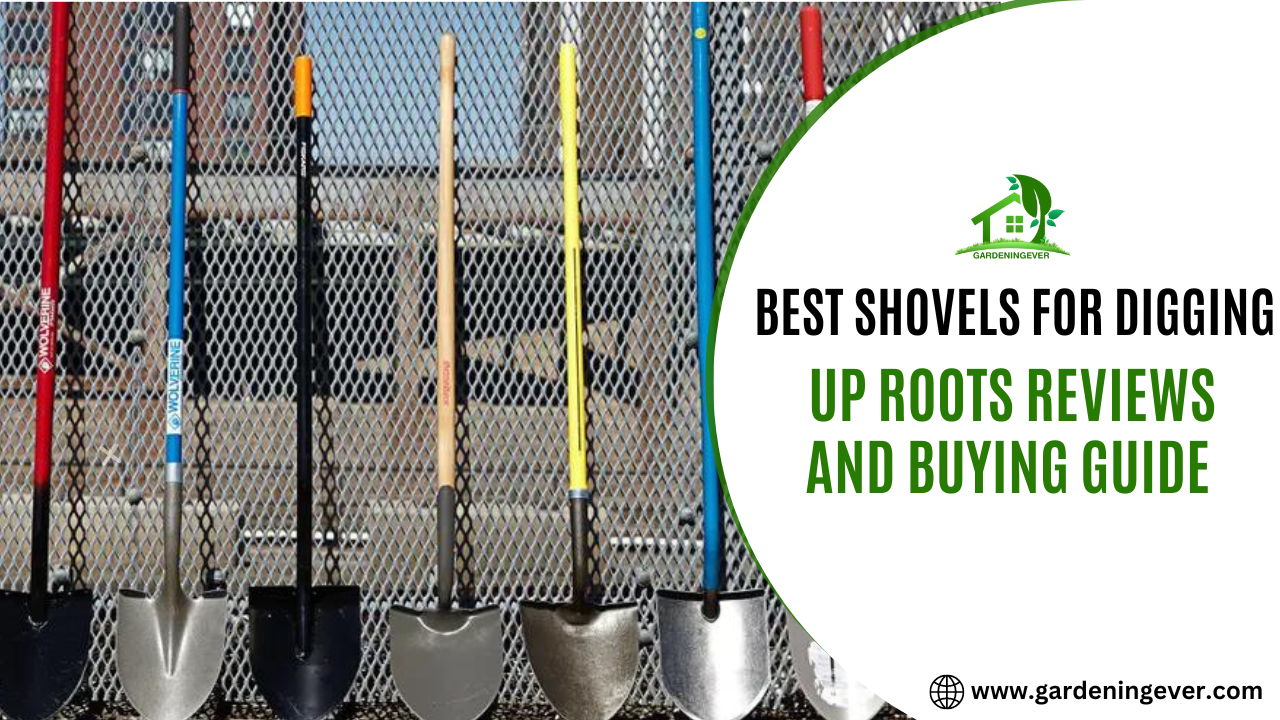Overgrown roots can be an utter hassle to deal with. Especially if you are a hobbyist and take up gardening in your free time, you’ll know how painfully annoying it can be to find unwanted roots in your backyard.
The unsightly growth of roots from the plants can also disrupt the overall aesthetics of your garden. Furthermore, if you let the roots grow out of control, they might end up damaging the underground plumbing and sewage pipes.
So, it’s apparent that digging up roots is essential if you want a hassle-free gardening experience. Choose the best shovel for digging up roots and prevent those pesky underground residuals from cracking up the foundation in your backyard.
In this article, we sum up a list of some of the best digging shovels in the market. A root cutter shovel will come in handy if you want to remove the roots manually. Although there are other possible methods to address the situation, this is the one that is found to be most effective.
Besides, we also have an in-depth buying guide to summarize the main factors you need to look out for when choosing the best shovel for digging up roots. Without further ado, let’s get right to it!
What Is The Best Way To Dig Up Roots?
Digging up those annoying roots in your garden is an essential task if you want a flawless gardening experience. But there is no perfect process to do so.
Avid gardeners use a diverse array of methods to get rid of the unwanted tree stump and roots in the garden. Some prefer physically digging them up using the best shovel for digging up roots, while others prefer using chemical treatment or rock salts.
Whether you decide to do it on your own or hire a gardening professional to do it, the best way to dig up roots is the manual process. By far, it’s the most effective option.
The two most popular options to manually dig up roots are using a shovel and using a stump grinder. While both processes have their perks, we recommend going for the first one.
Using a best spade shovel for your root removal activity means you can manually dig around the suspected area and inspect it minutely. You can dig in deeper as you find more roots and pull them out by hand as you go further. Although it will take more time, the results will come out much cleaner and more effective.
The stump grinder is the more heavy-duty approach when you have less time but a more severe root problem. Stump grinders can be expensive as well. Along with the safety goggles and protective headgear you’ll need, it might end up costing you quite a lot. The uprooting process, however, will be much quicker and extensive. You can even remove an entire stump altogether instead of manually shoveling around.
Nonetheless, we still suggest the first method of using root cutting shovels as the most efficient and cost-effective method to dig up roots. The rest depends on your judgment and requirements.
Top 9 Best Shovels For Digging Up Roots Review.
Like we said earlier, effectively digging up roots from your garden requires you to choose the best digging shovel. But as we analyzed the market, we found that not all shovels are made equal, and many products outperform others.
Here, we bring you a list of the nine best shovel for digging up roots. Choose one from our index, and you should be ready to get rid of your gardening problems once and for all!
1. Radius Garden 22011 Root Slayer Shovel
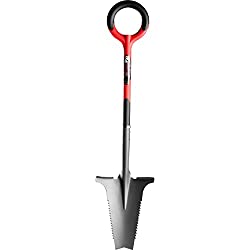
Specifications:
The design of the shovel is ergonomic. It causes minimal strain to the wrist and hands. You can perform almost all types of regular gardening tasks with this shovel, including digging up roots.
Top Features
– Serrated Blades
– V-shaped tip
– Power-coated with carbon steel
– Lifetime warranty from manufacturers
– Paddle-shaped handle
Summary:
If you want the best performance from a root-cutting shovel that glides through the dirt like butter, this is your best bet.
2. ROOT ASSASSIN Shovel RA-002 Carbon Steel Shovel Review.
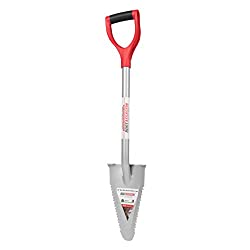
Specifications:
With a curved tip and serrated blades, you can deploy this sturdy shovel to various tasks besides just digging up roots. The rubber-coated handle is a bonus for accessibility.
Top Features
– Saw like teeth on the blade
– Powder-coated solid steel blade
– Small design with easy portability
– Simple maintenance
Summary:
Say hello to quick digging and effortless root cutting with this shovel. You’re in for an effortless gardening experience if you get this one.
3. AMES 2672100 Aluminum Scoop with Hardwood Handle and D-Grip Review.
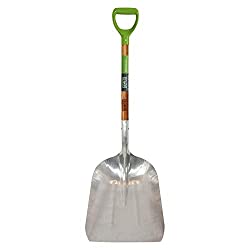
Specifications:
Weighing at just over three pounds, this shovel has the strength and durability of a beast. It is also designed with meticulous perfection for more delicate jobs that need more control and finesse.
Top Features
– Tempered aluminum blade
– Resistant to rust
– Poly D-grip on the handle
Summary:
If you are looking for maximum control and leverage over your shoveling activity, you can choose this tool without batting an eye.
Also See: Best Tiller For Roots
4. Fiskars 46 Inch Steel D-handle Digging Shovel Review.
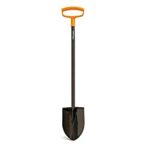
Specifications:
Getting good at digging up roots? Want a bit more challenge? Bring on you’re a-game with this shovel designed for expert root cutting jobs. Penetrate the most hardened soil and cut off the most strong roots with ease.
Top Features
– Hardened 18-gauge steel shaft
– Special 14-gauge steel blade
– Fully powder coated in black
– Oversized step design in the handle
Summary: The durable build is the name of the game with this shovel. Bid farewell to the days when you had to replace your tools frequently. Get one of these, and you should be set for life.
5. Spear Head Spade, Long Handle, Reinforced Fiber Glass, Gardening Shovel

Specifications:
With innovation and the latest technology combined, this shovel peeks into the future of gardening experiences. It has a patented design in its blade for maximum root cutting efficiency with minimum effort. You can dig deeper even into the most compacted rocky soil.
Top Features
– Carbon manganese blade
– Handle and shaft built with reinforced fiberglass
– Cushioned grips
– Stronger than EN-3388 standards
Summary:
If you’re a fan of innovative technology and want to try out up-and-coming tools, this shovel can give you a taste of both. Engage in next-generation gardening with this aesthetic-looking shovel.
6. Tabor Tools Shovel With Round Point Blade And Comfortable
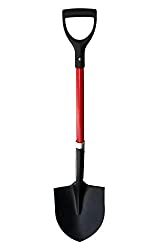
Specifications:
If you seem to have loose soil in your garden rather than rocky or compact terrains, opt for this shovel without any hesitations. The light-weight build does not lack in terms of features or design at all. It’s also great for people with relatively short stature.
Top Features
Top Features
– Built-in comfortable D-grip
– Tempered steel head with heat-treated alloy
– Powder-coated finish
– Fiberglass handle with no slippage
– Forward-turned step on the blade
Summary:
Camping trips and hiking can become much easier if you have this shovel with you. It’s reasonably suitable for lightweight root-cutting jobs as well.
7. Martha Stewart Mts-mds1 27-inch Mini Round Pt.
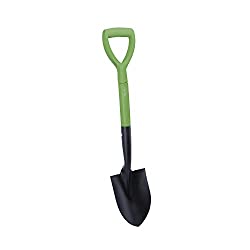
Specifications:
Get ready to get your hands dirty, as this tool is the perfect companion to hand shoveling. It is small and compact for a fine shoveling experience. The blade is sturdy enough to cut through roots and dig up dirt as well.
Top Features
Top Features
– Hardwood handle
– Heat-treated with a powder coating
– 8-inch point steel blade
– D-grip on handle
Summary:
If you find yourself kneeling and working at ground levels in your garden often, this is the shovel for you. The shorter shaft with sturdy blades is excellent for root cutting and clearing unwanted shrubs.
8. Bully Tools 82510 14-gauge Round Point Shovel.

Specifications:
Bid farewell to even the most problematic roots in your garden with this shovel. The design is mainly intended for heavy-duty construction site usage. However, it’s just as well-fitted for digging up roots.
Top Features
Top Features
– Proudly manufactured in the USA
– 14-gauge steel blade
– Polypropylene Co-Polymer used in D-grip
Summary:
If you are not satisfied with the featherlight shovels specifically intended for gardening use, you can opt for this heavy-duty shovel without second thoughts. It’s one of the sturdiest models out there.
9. The Ames Companies, Inc 2535800 Ames D-handle Digging Shovel
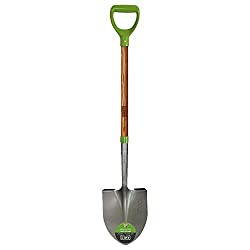
Specifications:
Comfortable and long-lasting durability are the two most vital features of this heavy-duty shovel. You will not feel much strain on your wrists even if you use them to dig up roots in hard soil. There is good impact resistance as well that prevents it from bending under excess pressure.
Top Features
– Tempered steel build
– Round edge blades
– Secure placement with comfort space
– Cushion end grip
Summary:
Tired of switching your shovels frequently? Don’t worry about getting a new shovel ever again if you have this sturdy one with you. It’s durable and long-lasting for a lifetime.
Best Shovel For Digging Up Roots: An In-depth Buying Guide
The best shovel for digging up roots must meet specific criteria before making the cut to our list. Here, we try to summarize the crucial factors you need to look out for before buying the best digging shovel for your garden.
Blade Material
The blade is the most crucial organ of the shovel. It’s the part that cuts through the dirt and essentially digs up the roots. So, having the most sturdy and long-lasting build is necessary for the blade.
The most common materials used in making the blade are steel, aluminum, and plastic – the first one being the most expensive.
Steel
Steel blades are the most acceptable choice and can take in the most damage. Although the finest steel quality can be quite expensive and heavy to handle, it is still the most premium variant. Usually, 12 or14-gauge steel is used. However, 16-gauge steel is also found in some blades.
Plastic
Plastic blades are simply for light-weight beginner use. You can’t indulge in heavy-duty jobs or work in harsh weather with it. But if you intend just to get a temporary solution at a cheap price range, plastic blades are the way to go.
Aluminum
Aluminum blades are basically a compromise between the two variants. Although it’s not as common or traditional as steel, it’s one of the more affordable yet reasonable choices. Aluminum blades can dig through the dirt just as efficiently as steel without weighing as much. It’s also sturdier and more practical than plastic.
Blade Shape
You need a blade that is pointy enough to penetrate the ground. The edges of the blade also need to be sharp so that you can effectively cut the roots before digging them up.
Blades can be of a wide variety of shapes and structures, and each variant has a specified utility.
Round-Point
If you have rocky soil in your garden, you need to put in more effort digging through the dirt rather than cutting roots. In that case, a rounded pint blade is your best friend. Since all the pressure is focused on the blade’s tip, it can dig up dirt quite nicely and let you reach the deeper roots easily.
Serrated
A garden with loamy soil would demand less effort to dig up dirt. Instead, it would be best if you focused more on quickly cutting up the roots. That is where serrated blades come in. Just simply remove the soft loamy soil and use the knife-like sharp edges of this root-cutting shovel to cut up the roots with easy movement.
Inverted V
This innovative blade shape is a combination of both. Instead of a single point like in round-point blades, these shovels have two points to allow better penetration. So you can dig up the soil more effectively. Interestingly, the straight edges help cut up roots quite nicely, too, much like the serrated blades.
Blade Size
This choice solely depends on the type and intensity of the digging you require. If you’re good with some superficial digging, small blades might be useful. However, for most extensive root digging jobs, choosing a shovel with large edges is essential.
However, note that larger blades might add up to the weight of the shovel. So, you’ll need more energy to work with it.
Shaft Material & Length
Just like the blade’s weight and size, the shaft of the shovel is a crucial factor to consider. Having the wrong shaft length for your shovel can induce severe back pain and prevent you from working in your garden for extended periods. It would be best if you had the most suitable length of the shaft compatible with your height.
Also, you need to consider the build quality of the shaft. There are three most common materials used in making shafts for shovels.
steel
Classical shovels have the usual steel materials and can be the sturdiest. A premium 16-gauge steel shaft can withstand massive pressure and work through a long luster. However, they tend to be a bit on the expensive and heavier side.
Hardwood
A cheaper choice would be the hardwood shafts. These shafts tend to work well in lightweight digging but can instantly snap if you put too much pressure. Also, the wicker tends to get weaker with time as you expose it to more moisture.
Fiberglass
A more modern alternative is the fiberglass shaft. Immune to most environmental factors like moisture, heat, or impacts, synthetic fiberglass can be quite sturdy as well. It’s somewhat flexible and aesthetic-looking too.
Handle & Grip Quality
Handles can either make or break your whole shoveling experience. Choosing the best design for the handle is essential if you want a comfortable experience while digging up roots.
The most common handle design is the straight grip. But it’s not suitable for when you want to apply a lot of pressure to the soil directly. Using it for long can cause blisters and damage your wrist in the long run.
There are many design variants of the grip, including the D-grip, L-grip, O-grip, and T-grip.
The D-grip is the most popular variant with the most ergonomic design. It’s most comfortable to use since it has both an arc and a flat-top.
O-grips have a rounded handle that allows two people to use a shovel together. You can hold the handle from both sides along the arc.
L-grips and T-grips are more oriented towards light-weight, more nuanced usage. However, these shapes are not recommended due to the lack of grip. Your hands can easily slip and cause accidents during heavy use.
Weight
This factor, once again, is entirely subjective to the user. The shovels’ weight varies a lot depending on the type and size of the blade you choose. Even the slightest variation in the shovel weight can make a huge difference in your experience.
Just because the shovel is heavy with sturdy materials doesn’t mean it’ll be suitable for you. Excessive weights might cause wrist damage and fatigue while you work. So, light-weight variants are more preferable. You need to make a balance between the two factors.
So, we encourage you to try out various shovels of varying weights before setting your mind on one.
Frequently Asked Questions (FAQs)
Can I Leave Dead Roots In The Soil?
Dead roots are good decomposers and can act as a natural fertilizer. But that takes a long time. If you don’t plan on renovating your garden soon, leaving dead roots in the soil can bring in some benefits to your existing plants.
best top soil for grass ?
A loamy soil is best because its rich in nutrients and drainage-friendly soil with a pH between 6.0 and 7.0 is ideal for grass. This type of soil supports the growth and growing of grass roots, results in a vibrant green lawn.
Can A Plant With Root Rot Be Saved?
The short answer is no. Because root rot is devastating as it mushes up the entire root system of a plant. However, if you see some viable white roots after digging it up, you can still salvage the plant. You need to replant it in fresh new soil with better nutrients. If all factors are favorable, the pant with root rot might be saved.
Do I Throw Away Old Potting Soil?
Old potting soil can contain disease-causing pathogens. So, unless you’re entirely sure that the older plant was healthy and free from any diseases, you should throw away the potting soil.
Can I Reuse Soil After Root Rot?
Root rot can be devastating for plants. You need to dig them up as much as you can. After the residual roots have rotted away, you can salvage the soil and reuse it. But a good idea is to mix it with fresh new soil for better nutrient supply to the new plants.
How Long Does It Take For Roots To Decompose?
Roots are quite sturdy, mostly when underground. Even after the plant is dead, roots can take up to five years to properly decompose.
Can I Plant Over Old Roots?
Old roots tend to stay in the soil for quite a long time. Even if you plant new trees over them, they might interfere with the new root network, essentially hampering the tree growth. So, it’s not a good idea.
Final Verdict
Shovels are part and parcel of a gardener’s toolbox. However, it is not always the same shovel that does all types of jobs efficiently. When it comes to digging up roots, there are specialized shovels like the ones on our list.
Depending on the blade shape, handle size, and build quality, the best shovel for digging up roots has some specific criteria they need to meet. We tried to sum up the best of the best in our in-depth buying guide.
After all analysis, we think the Radius Garden 22011 Root Slayer Shovel has the overall best performance in terms of features. Even in the toughest of terrains, the shovel can extensively dig up dirt and cut through roots. The design of the shaft and shape of the blade is ergonomically designed for the best outcome.
All in all, you should now know all about choosing the best shovel for digging up roots. Consult our in-depth buying guide, or just pick one from our list to get started with. We hope you soon find the most suitable shovel for your needs. Happy gardening!

